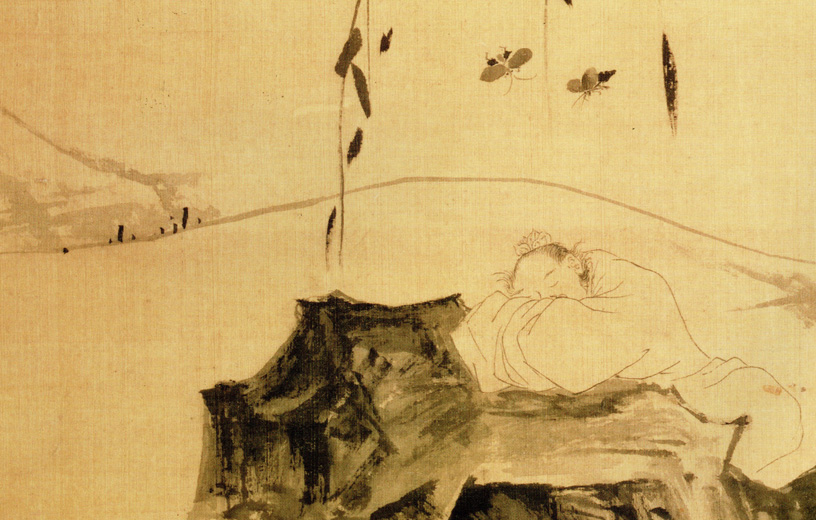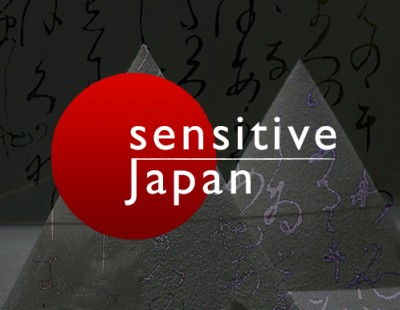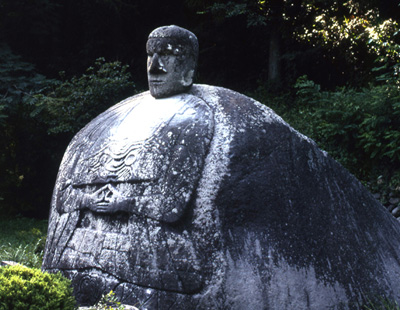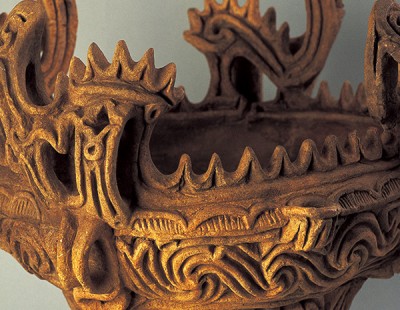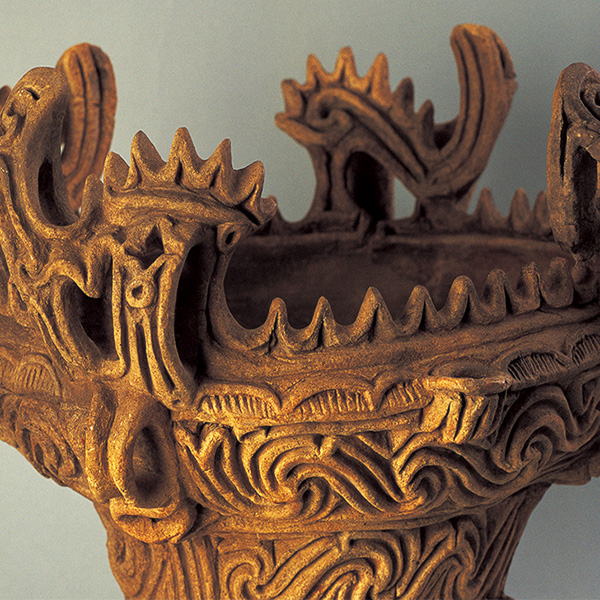Japanese culture is said to be very stylized. There is also a common idea that Japanese arts and crafts had nothing to do with realism until modern times. Such an analysis is not necessarily accurate, but when one looks at the anime, manga, games and J-POP that are considered representative of Japan’s culture today, it is certainly true that the Japanese sense of what is “real” still seems somewhat different from the Western concept of reality.
Starting from the Form
When teaching the techniques and knowhow of flower arrangement, the tea ceremony, Japanese poetry, calligraphy, and martial arts, the emphasis is always first and foremost on the form, or kata, as it is called in Japanese. That is, the most important thing is to inherit the kata. Once in a blue moon a “kata-breaker” comes along, his or her unique style is recognized as a kata in its own right, and a new school is born, but the new kata is still a kata. The adjective katai means “hard” and “solid” (and for that matter also “stiff” and “formal”), but that is just how it looks or how it feels to the touch. The kata is only an empty container, a mold. It doesn’t become a genuine style until you pour your soul or spirit into it. Often the secrets of the art, its soul and spirit as it were, are only passed along orally, in private, from master to disciple.
A kata is a model, a pattern, a form, a proper way of doing things. A homonym written with another character means “one side of a pair,” a fragment, something incomplete. The complement of that sense of kata is ma, which means “true” and stands for completeness. When the Japanese developed their own writing system back in the early Heian period, the kanji characters imported from China were regarded as perfect and complete and known as mana (“true names”). In contrast, the newly created cursive characters were considered trifling and incomplete, and were called kana (“temporary names”), as in hiragana and katakana.
A kata that is full of spirit and beauty becomes a katachi (“shape”). Chi signifies direction and beauty, and also means “soul” as in the words inochi (“life”) and orochi (“snake”). Incidentally, i in inochi means “breath”; life is “the breath of the soul.” Snakes shed their skin and hibernate, and for that reason they have been considered living symbols of the rebirth of the soul ever since the ancient Jomon period.
Be that as it may, Japanese crafts and performing arts are traditionally taught from the kata, because that is precisely where the soul will eventually reside, or so it is believed.
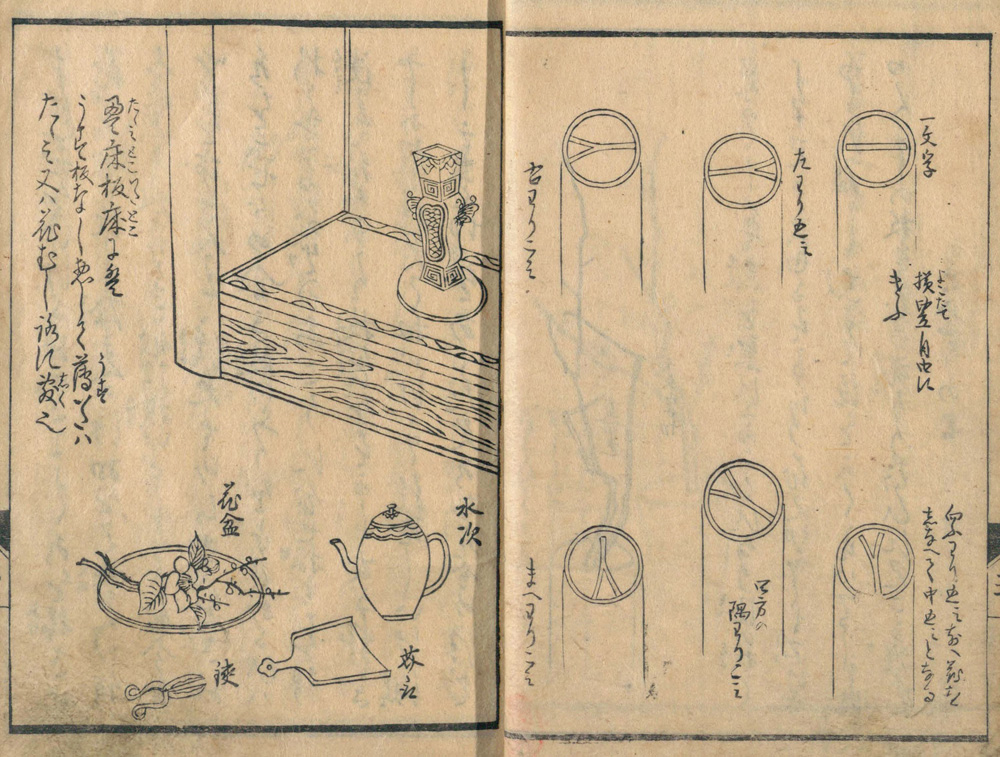
Plenty of manuals for the arts were published during the Edo period. The illustration is from a 1769 handbook for Furuta-ryu ikebana for private study.
Godzilla Strikes a Pose
This can be clearly seen in the performing arts, such as Noh and Kabuki. The Noh stage is extremely stylized, and there are no sets to change between programs. The face is the most expressive part of the body and the place where a person’s will and emotions are easiest shown, but in the Noh theatre live expressions are abolished, and the face is usually covered with a mask.
Kabuki is a more popular form of entertainment, but here too the stage props are flat, and all expressions of pain and pleasure are highly stylized. In this respect, Kabuki is in marked contrast with Western opera, for example. A premise for a Kabuki play is that the audience shares the “world” of the play, or in other words that they are familiar with the story that unfolds, and know the characters and items that belong to that world, be it Chushingura and the forty-seven ronin or the rivalry between the Genji and Heike clans. Once you acknowledge that “world,” the flat props and stylized expressions begin to seem real. Elaborate props and raw emotional expressions would on the contrary rather get in the way.
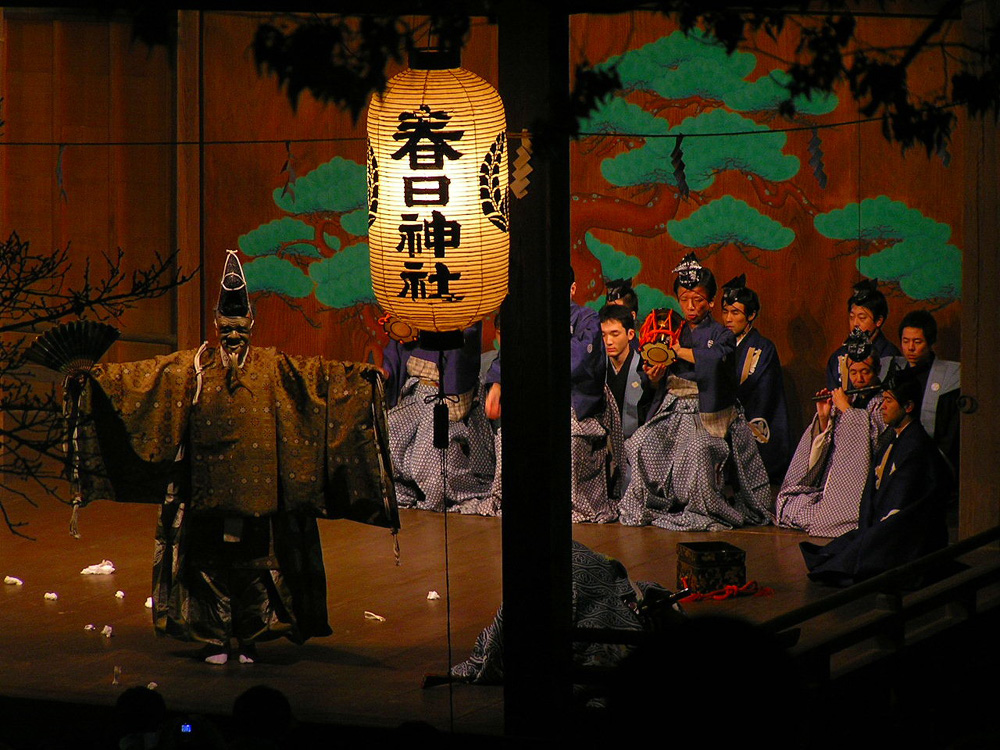
Noh stage at the Kasuga shrine, Sasayama, Hyogo pref. All Noh plays are performed in front of a wooden panel with a painting of a single pine tree.
This tradition has been inherited by modern performing arts as well. A striking example is the Godzilla movies made in Japan versus the Godzilla movies made in Hollywood. In the Hollywood versions, the producers strive to make everything as true to life as possible: the setting, the models, the backgrounds, etc. It is almost as if they were trying to shoot a documentary. In the Japanese Godzilla movies, on the other hand, it is obvious that Godzilla is a guy in a rubber suit and the cities are miniature sets, but as long as the viewer understands that this is “Godzilla’s world,” disbelief is suspended and nobody minds that the sets look fake. Sometimes the Japanese Godzilla even “acts” and strikes Kabuki-like poses, but that only makes him more real to Japanese audiences.
In the latest movie in the series, Shin Godzilla, which was a big hit last year, some of Godzilla’s CG motions were based on the movements of a Kyogen performer. Perhaps the stylized sliding feet of Noh and Kyogen also have a dimension of Japanese realism. Many of main characters in Noh plays are gods and spirits, visitors from “another world,” just like Godzilla.
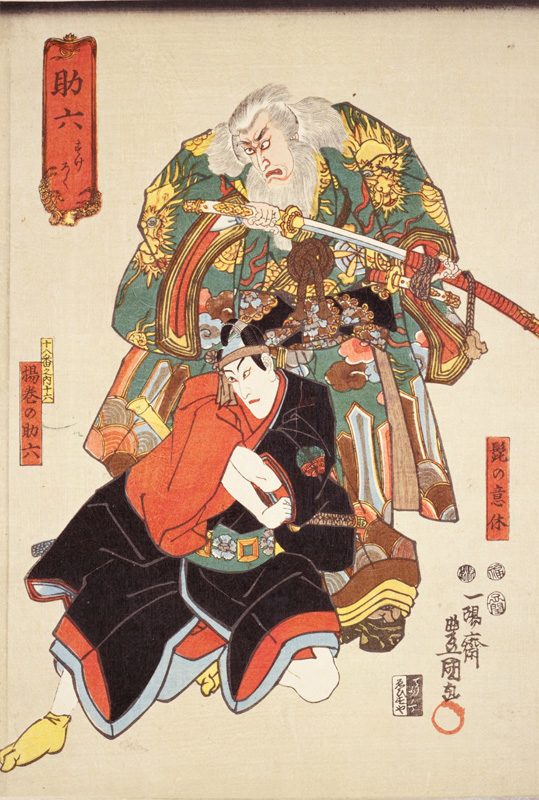
Sukeroku, no. 16 in the series Eighteen Great Kabuki Plays by Ichiyosai Toyokuni (Utagawa Kunisada), 1852. Kabuki actors don’t wear masks, but the facial expressions are extremely stylized.
In Japanese anime, nature is very realistically portrayed, and in particular the depiction of water and light aims for a thoroughgoing trueness to life, even as regarded from the Western point of view of realism. Many plants and animals are also drawn graphically. But with few exceptions, human faces and facial expressions are still drawn in the flat old manga style. The contrast with the brilliant three-dimensional depictions of the human form in Disney’s animations couldn’t be greater. Somehow human expressions in contemporary Japanese anime appear to carry on the time-honored tradition of Noh masks and ukiyoe paintings. It seems that the Japanese perception of what is “real” is still quite different from the West.
Japanese Hyperrealism and the Middle Ages
But in the long history of Japanese culture, there have also been times when graphic expressions close to realism were developed, such as the portraits and Buddhist sculptures from the Kamakura period. In the late Edo period, there were freak shows exhibiting hyperrealistic sculptures called “living dolls,” that were “exactly like the real thing.” However, as the fact that they were displayed in freak shows suggests, the living dolls weren’t exactly considered good taste, even at the time. Being “exactly like the real thing” was too unsophisticated for modern people.
The realism of the Kamakura period, on the other hand, may be called one of the peaks of Japanese visual expression. The era from the Kamakura period to the Muromachi period (roughly 12th-16th C) was a time when Japanese culture as a whole reached one of its highest summits. Many of today’s top craftsmen concur that that was the age when the supreme masterpieces of their crafts were created, the finest swords were made and the most beautiful temples were built. In the background of the glory of Japanese culture in the Kamakura and Muromachi periods (that is to say, the Middle Ages) was the development of a stabilized monetary economy and a transportation network that included the eastern provinces, as symbolized by the founding of the shogunate in Kamakura, far to the east of the imperial capital in Kyoto. Along with the goods and money, people moved around and exchanged and refined their skills.
Many of the art forms that are now considered representative of Japanese culture, such as the tea ceremony, ikebana and Noh, were brought to perfection in this period. However, perfection also means stagnation, or the beginning of the end. Before long, all these art forms were stylized into “proper ways,” that were transmitted through the generations as kata by particular schools or families. The prototype of the iemoto system which still lives on was established in the late Kamakura period. Calligraphy and poetry were born in the Heian period and remained highly imaginative and creative until the end of the Heian period, but in the Middle Ages these art forms too were taken over by certain families, who made sure everyone stuck to the established patterns and transmitted those traditions as kata.
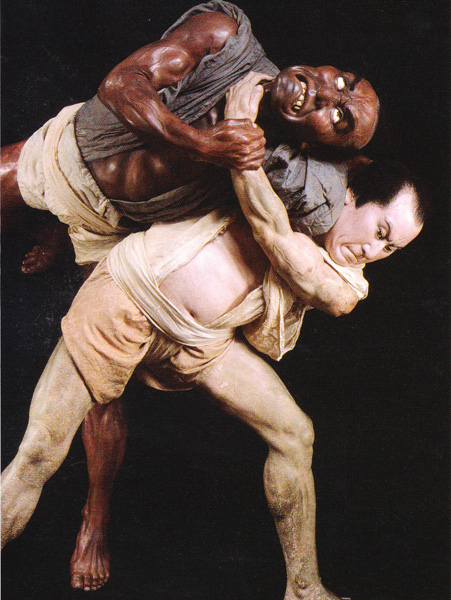
Nomi no Sukune Wrestling with Taima no Kehaya. Living dolls by Yasumoto Kamehachi (1890).
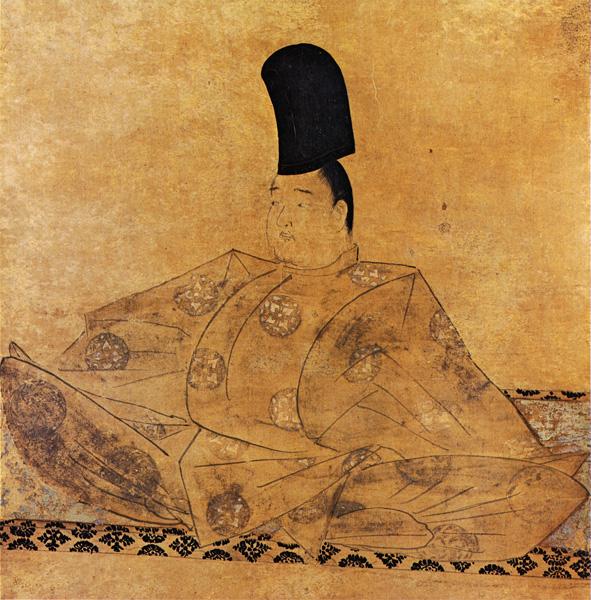
Portrait of Emperor Go-Toba (1180-1239). This realistic style of portraiture was common in the Kamakura period.
Realism between the Virtual and the Actual
Yume-utsutsu is a Japanese expression that refers to a state of being half asleep, half awake, between dream and reality. Yume means dream, or in contemporary terms we might call it “virtual.” Utsutsu means “reality,” the “actual” world. Yume-utsutsu has a sense of coming and going between illusion and reality, between the virtual and the actual. However, the reality that utsutsu refers to is an empty (utsu) world, a transient (utsurou) world. What we call reality is not that certain after all, or so the Japanese have believed since ancient times. Like utsura-utsura, which is an onomatopoetic expression for a shallow state of sleep, yume-utsutsu is not a comparison between dream and reality, but refers to the vague, dim state somewhere in between.
The sense of transitoriness is of course deeply connected with the environmental conditions in Japan, from the changes of the seasons to earthquakes, typhoons and other natural disasters, but the fact that the world can change from one moment to the next is hardly enough to give rise to the idea that reality itself is unreliable. One school of philosophy in ancient Greece also claimed that “all things are in a state of flux,” but by that they did not mean that dreams and reality are a single whole, or that reality is unreliable, as the Japanese did.
Another word that perhaps comes closer to the essence of Japanese “realism” is hakanashi, which means “impermanent” or “all too brief.” This sense is vividly apparent in the famous Iroha poem, composed in the late Heian period and subsequently the basis for the ordering of the Japanese syllabary: “Even the blossoming flowers will eventually scatter. Who in our world is unchanging? Today we cross the deep mountains of Karma, and there will be no more shallow dreams, no more delusions.” The sensation of hakanashi is profoundly linked to the Buddhist sense of the vanity of life, and already Prince Shotoku (574-622) had emphasized the impermanence of the world. Throughout the Heian period the Buddhist notion of impermanence went hand in hand with the sense of hakanashi, and eventually led to an “aesthetics of hakanasa” in the poetry of the 10th century court lady Izumi Shikibu.
Etymologically speaking, haka originally referred to the amount of work to be done when planting or harvesting rice. This sense still lingers in words like hakadoru, “to make progress.” Hakanashi means “no workload,” that is to say, no reality. As a verb, hakaru means “to measure,” and written with various kanji came to include a wide range of meanings such as “to discuss,” “to make plans” and “to attempt.” Haka (written with yet another character) is also the word for “tomb,” and that meaning is probably not totally unrelated either.
Hakanashi is the aimless reality beyond measurements, regulation and plans. Of major importance in spreading and firmly entrenching the notions of hakanashi and the vanity of life were the first lines in the Tale of the Heike: “The Jetavana bells ring the passing of all things.” The tale was originally composed in the mid-Kamakura period as a long ballad to be chanted to biwa accompaniment, and it became a smash hit. As in the other performing arts that arose around the same time, the Heike ballad was like a grand sum of the traditions up to that point, and it is one of the great peaks of Japanese music.
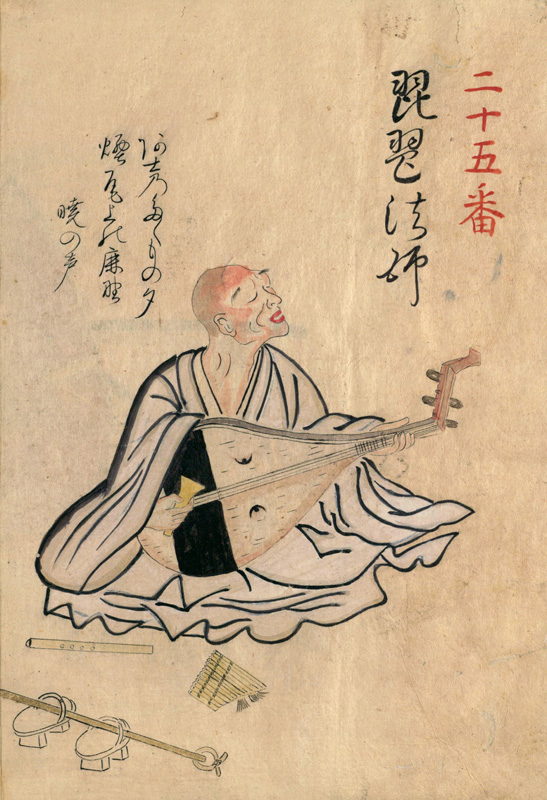
Biwa-playing monk. The Tale of the Heike was originally chanted by blind monks to biwa accompaniment. From the Edo period collection Shokunin Zukushi Uta-awase (“Poetry Contest on the Theme of Craftsmen”).
Beyond the Measurable
Thus the concepts of hakanashi and transience became deeply rooted in the Japanese psyche, and this later gave birth to the aesthetics of wabi-sabi. The word wabi has the same root as wabiru (“to apologize”) and wabishii (“dreary, miserable”), while sabi means “rust” and is the root of sabishii (“lonely”). One trigger was the Onin War (1467-1477), in which much of Kyoto’s cultural heritage was destroyed and many old traditions were lost. The impact was enormous. The supposedly perfect beauty created by human hands turned out to be fleeting and all too brief after all. Instead, a new kind of beauty that was both ephemeral and hard to measure was found in patinated old writings and paintings, and in the “scenery” of earthenware born out of water and flames beyond the craftsman’s intentions.
Even so, the Japanese arts continued to emphasize their kata and were obsessed by handing down the traditions through the generations. Maybe it was because they saw something vaguely measurable, something barely actual in the kata even in a fleeting, impermanent world. Or to put it differently, they believed that the genuine reality was ephemeral and therefore lay beyond the limits of the measurable. While modern rationalism claims that reality is the aggregate of things that can be measured, the Japanese seem to have searched for reality in ephemeral things, in things that could not be measured. Perhaps that is what realism still means to the Japanese, from Manyoshu to contemporary anime, from the Noh theatre to Godzilla movies.
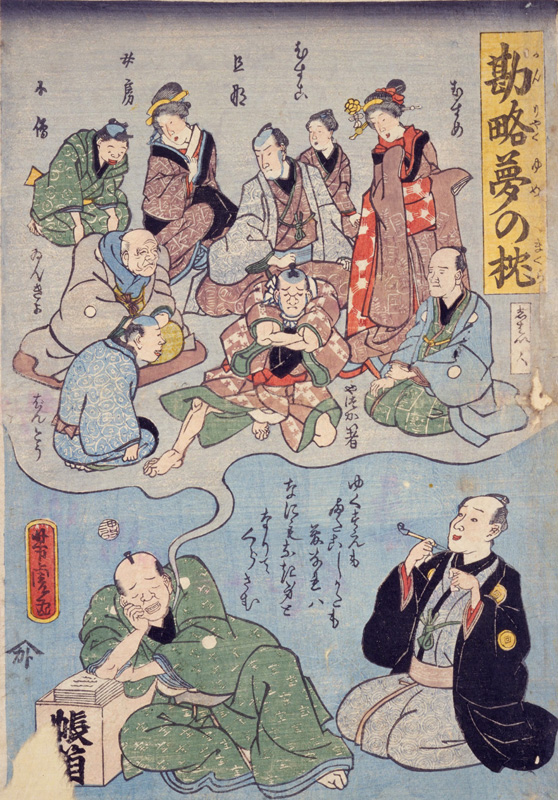
A Simple Dream by Utagawa Yoshitora. Dreams were a popular motif among Edo period writers and ukiyoe artists.
